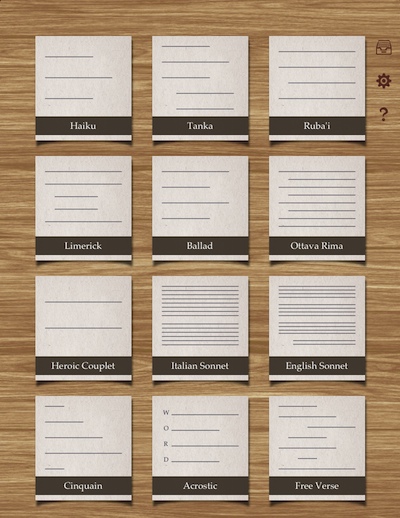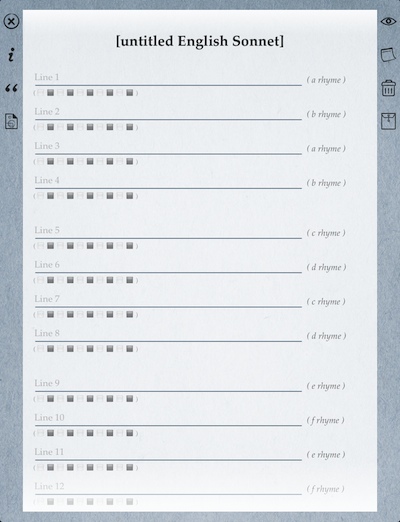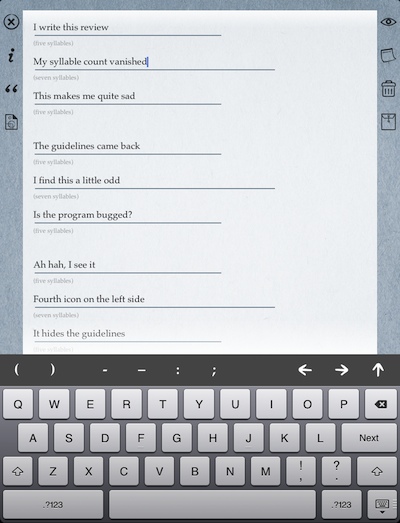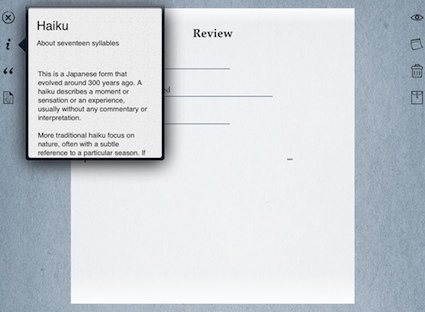It’s been a while since I last compared any thees to summers days. I might once have come up with thousands of ways to love thee, I sort of lost count of them all. Thankfully, when I’m feeling poetic, I don’t need to dig out old High School English textbooks to remind myself how many iambics are in a pentameter. With Line & Verse, you, too, can write technically accurate poetry. It won’t make you a poet – Line & Verse won’t serve as your muse, unless you’re inspired to write an ode to iOS apps – but you should at least find it a breeze to keep the meter.
Line & Verse has a nice, simple layout. On opening the app, you can choose your poetry form from a clutter-free gallery. In seconds, you can start writing your haiku, English sonnet, limerick, ballad, go wild with free verse, or compose in one of the other forms (there are twelve in all). The basic structure of the poetry type lays out how many lines your chosen form traditionally has, and helpfully lays out for you the meter, number of syllables, and/or rhyming structure. If you’re feeling adventurous, you can turn off the guidelines by selecting the blueprint icon on the bottom left side of your composition (though this feature wasn’t immediately clear, and when I pressed it, I didn’t notice that the guides had vanished, leaving me to think that (a) the icon didn’t do anything and later (b) the program was bugged and took away my hints… it was working as designed, I just didn’t know what the design was at the time).
The Line & Verse app gives you a number of features. Informative help text gives you more details, though not overwhelmingly so, into the technical and historical background of poetry types, individual lines or couplets, and more. The layout is simple and easy to navigate, once you know what the icons do (there is no harm in trial and error and the icons’ purposes are intuitive). Line & Verse adds a helpful additional bar with a few of the punctuation marks you would normally have to navigate to the number and symbol modes for the keyboard. With the tap of an icon, you can view historical examples of the format in which you’re working. You can preview the poem or look up the definitions of words in the built in dictionary (just select the work as you would to copy/paste and swipe over to “Define”). Elsewise provided no rhyming dictionary, but this was a deliberate decision, which fits nicely with their omission of mechanical enforcement of structure, meter, and rhyme. Elsewise wants you to be able to break the rules if you wish—something that is part and parcel of poetry as art. You can add notes to a poem you’re working on. Finally, you can share your finished poem with your real life muse via iTunes, e-mail, paste into other documents, and save as PDF files.
Line & Verse is a great tool for the casual poet (if you’re a hardcore poet, slamming stream-of-consciousness free verse in smoky coffee bars, you either already know the various format rules or break them at every opportunity). With little to get in the way of the poetry-creating experience, if you want to emulate the bard with an accurately structured a-b-a-b, c-d-c-d, e-f-e-f, g-g sonnet, Line & Verse is the way to go.
Or rather:
Go buy Line & Verse.
Write poetry in the spring
On your iPad… um… thing.
Special Thanks to Ben for being the Poet in our group and submitting the above




